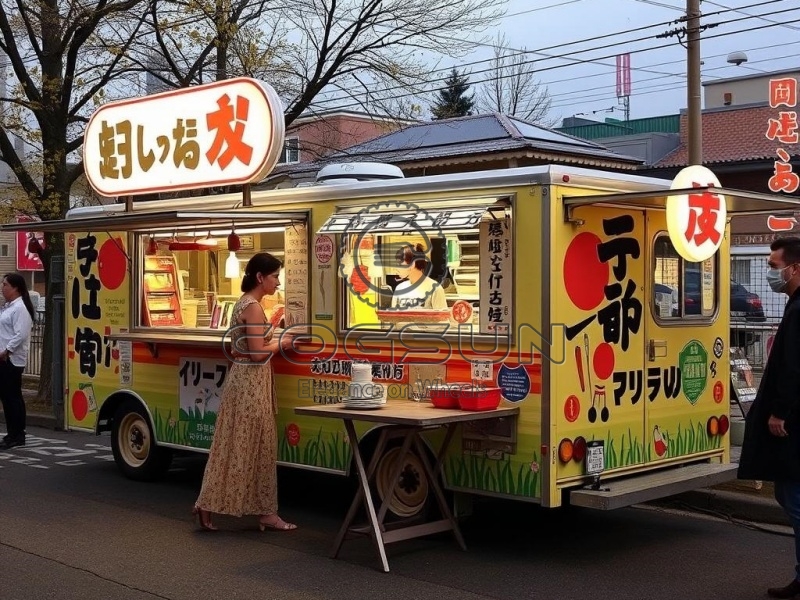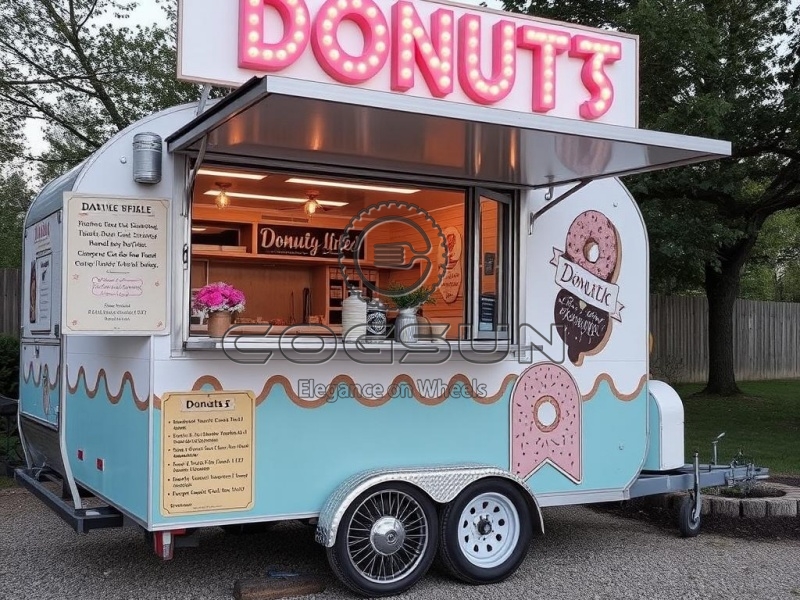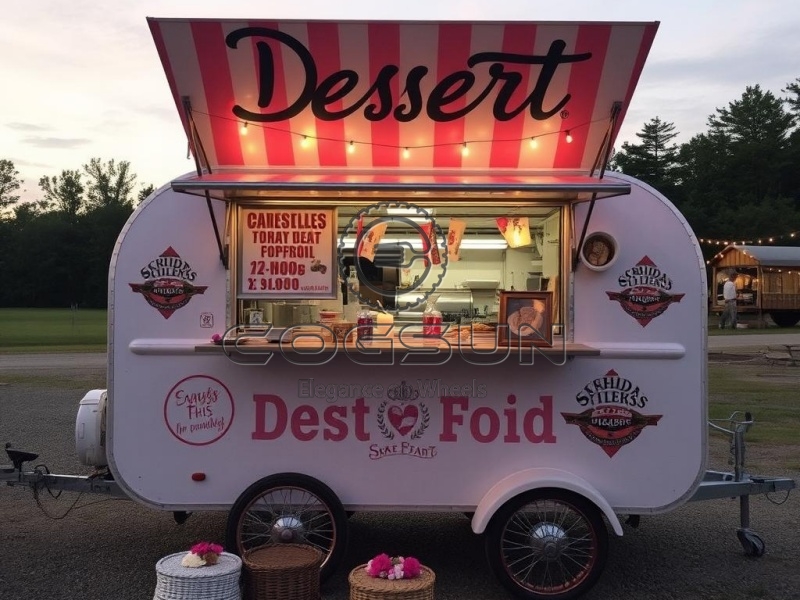Japanese food trucks are designed with the philosophy of “small yet exquisite, beautiful and elegant.” Their bodies are often finished in natural wood, matte black, or indigo blue. Handwritten calligraphy menus, bamboo lanterns, and ukiyo-e prints create a visual tension that “combines Zen and everyday life.” Some high-end food trucks even feature miniature dry landscape gardens or retractable shoji doors. While waiting in line, customers can watch the chefs slice sashimi through the windows or listen to the “culinary symphony” of ingredients sizzling on the teppanyaki grill.

Features
1. Ultimate Single Product: One Car, One Skill, One Life
- Ramen Cart: Offers only three broths (pork bone, miso, and salt). Noodle thickness, egg doneness, and chashu thickness can all be customized. Chefs must be certified by the Ramen Association.
- Crepe Cart: Insisting on using Hokkaido Tokachi milk and French AOP butter, the crepes are freshly rolled and the fillings (such as caramelized bananas and matcha cream) are fried fresh. Customers can watch the chef flip the crepes with his “whirlwind” technique.
- Sake Cart: Equipped with a mini-freezer and tasting counter, it offers “sake and wagashi” combos. The sommelier recommends cold (snow-cold) or warm (smoked sake) based on customer preferences and explains the meaning of the haiku on the label.
2. Ritual Design: An Immersive Experience from Taste to All Five Senses
- “Opening Ceremony”: When ordering takoyaki, the chef will first hand customers a sheet of nori seaweed, allowing them to wrap the piping hot balls themselves, enjoying the triple textures of crispness, softness, and springiness.
- “Seasonal Specials”: Spring offers Sakura Ebi Don (paper cherry blossoms hang from the roof), summer offers Nagasaki Somen (bamboo sink in the rear), autumn features Matsutake Rice (documentaries about matsutake harvesting are played inside the car), and winter offers Strawberry Daifuku (snow-themed window paper-cuts are applied to the windows).
- “Aesthetics of Imperfection”: The tableware intentionally retains traces of handicraft (such as cracked glaze on ceramic bowls and rough edges on wooden chopsticks), echoing the wabi-sabi philosophy of “perfection in imperfection.”
3. Sustainable Practices: Zero Waste and Recyclable “Lightweight Living”
- Ingredient Recycling: Fish bones are boiled into soup and made into cat snacks, tofu dregs are fermented into miso, and discarded rice grains are used to brew sake lees face masks.
- Energy Self-Sufficiency: Rooftop photovoltaic panels and side-mounted vertical-axis wind turbines combine to generate power, and biodiesel (derived from waste cooking oil) is used at night.
- Packaging Revolution: Onigiri are wrapped in edible rice paper, bamboo lunch boxes must be returned, cleaned, and reused (otherwise, an “ecological compensation fee” will be charged), and straws are made from fern fiber.
Internal Equipment
1. Intelligent Cooking System
- Ramen Robotic Arm: Uses 3D vision to identify noodle firmness and automatically adjusts cooking time. The broth temperature is dynamically adjusted by AI based on weather data.
- Molecular Gastronomy Module: A liquid nitrogen quick-freezer creates “sakura sorbet,” while an ultrasonic oscillator atomizes soy sauce into a “flavor mist” that is sprayed on sashimi to enhance flavor.
- Automated Sushi Production Line: From steaming rice to slicing fish to rolling and shaping, the entire process is unmanned, but a sushi chef maintains remote monitoring to ensure rice temperature and fish freshness.
2. Environmental Protection and Energy Module
- Hydrogen Fuel Cell: Powers high-temperature cooking equipment, emitting only water vapor, making it suitable for indoor shopping mall operations.
- Water Recycling and Purification System: Wastewater undergoes three stages of filtration, reaching drinking water standards, and can be used for washing food or brewing matcha.
- Intelligent Waste Compacting: Food waste is dehydrated and compressed, reducing its volume by 80%. The compressed waste can be converted into biomass fuel to heat the food truck at night.
3. Digital Operations Hub
- Dynamic Menu Screen: Displays real-time ingredient traceability information, wait times, and carbon footprint;
- Customer Interaction Terminal: The touchscreen supports ordering in Japanese, English, and Chinese, offers a “Japanese Cuisine Culture Quiz,” and features AR games in the children’s area;
- Remote Monitoring System: Vehicle owners can view device status, inventory levels, and sales data via a mobile app. The system automatically generates an “ingredient restocking list” and contacts suppliers.
Applications
1. Local Life Services
- Community Care Economy: Mobile senior living food trucks are deployed in aging communities, providing low-sugar and low-salt “care lunch boxes” with handwritten health tips;
- Cultural Heritage Education: Partnering with schools to launch a “Japanese Cuisine Lab,” where students can use the truck’s equipment to make dorayaki and learn the aesthetics of “one sauce, three vegetables” plating;
- Disaster Response: After an earthquake, the truck was quickly transformed into a “mobile rescue kitchen,” using an onboard water purification system and solar cookers to provide hot meals. Rooftop LED lights serve as temporary signal lights.
2. Empowering the Tourism Economy
- Themed Route Development: Collaborating with travel agencies to launch “Japanese Cuisine Tours,” visitors ride vintage trams through food truck hotspots like Osaka’s Dotonbori and Kyoto’s Nishiki Market. By collecting stamps and checking in, visitors can redeem limited-edition Japanese sweets.
- High-End Event Customization: Providing “mobile kaiseki” for weddings, where the food truck unfolds into a 3-meter-long table, where chefs prepare “hachisun” (appetizer platters) accompanied by live shakuhachi music.
- Cultural Export: Opening the “Tokyo Night Diner” food truck at the foot of the Eiffel Tower in Paris, offering French-Japanese fusion cuisine and playing clips from “Midnight Diner” on a large screen outside the truck.
3. Global Outreach
- Overseas Pop-up Stores: “Desert Ramen” launched at the Dubai Desert Festival, featuring a broth made with camel milk instead of cow’s milk, paired with dates and Arabica coffee; “Zen Sushi Bar” opened in São Paulo, Brazil, seasoned with Amazon rainforest fruit vinegar;
- Retail Expansion: “Ready-to-Eat Japanese Meal Kits” launched in collaboration with convenience stores, reaching over 30 countries worldwide;
- Cultural IP Collaborations: “My Neighbor Totoro Onigiri” launched in collaboration with Studio Ghibli, and “Hello Kitty Dorayaki” with Sanrio, achieving annual sales exceeding 5 billion yen.




